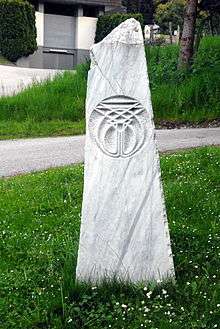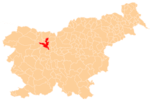Marko Pogačnik

Marko Pogačnik (1969)
Marko Pogačnik (born 11 August 1944 in Kranj, Slovenia, Yugoslavia) is a Slovenian artist and author.
Background
Pogačnik studied at the Academy of Arts in Ljubljana, the capital of Slovenia, where he graduated in 1967. He was a co-founder of the neo-avantgarde artistic movement OHO,[1] members of which were also Tomaž Šalamun and Slavoj Žižek. From the 1980s, he embraced a holistic vision of art. He claims to have developed a method of earth healing similar to acupuncture by using pillars and positioning them on so called 'lithopuncture' points of the landscape.[1]
In 1991, he designed the official coat of arms of the newly constituted Republic of Slovenia. In the year 2006, he joined the Movement for Justice and Development led by Janez Drnovšek, the President of Slovenia at the time.
He lives and works in the village of Šempas in the lower Vipava Valley. In the last decade, the town of Nova Gorica, in which municipal territory he resides, has commissioned a number of public monuments from Pogačnik, most notably the monument to the 1000 years of the first mention of Gorica and Solkan, which stands in the town's central public square.
Since 2008, a group of his monuments and birch trees, titled the Hologram of Europe (Slovene: Hologram Evrope), stands at the crossroad of Tivoli Street (Tivolska cesta) and Slovene Street (Slovenska cesta) in Ljubljana.[1]
Awards
In 1991, Marko Pogačnik received the Prešeren Fund Award for his work.[1] In 2008, he received the Jakopič Award, the central Slovenian fine arts award.[1] He was nominated two times for the Right Livelihood Award.[1]
Publications
- Nature Spirits and Elemental Beings - Working with the Intelligence in Nature (Findhorn Press, Scotland, 1996).
References
External links
|
|---|
|
| 1960s | |
|---|
|
| 1970s | |
|---|
|
| 1980s |
- 1980: Danilo Benedičič
- Evgen Car
- Anton Demšar
- Karpo Godina
- Irena Grafenauer
- Niko Grafenauer
- Stane Jagodič
- Norina Jankovič
- Minu Kjuder
- Rudolf Kotnik
- Tone Partljič
- Bogdan Reichenberg
- Marjan Rožanc
- Dubravka Sambolec
- Mira Sardoč
- Ati Soss
- Marko Dekleva, Matjaž Garzarolli, Vojteh Ravnikar in Egon Vatovec
- Janez Bizjak, Marko Cotič in Dušan Engelsberger
- 1981: Janez Albreht
- Ljerka Belak
- Alenka Gerlovič
- Herman Gvardjančič
- Janez Hočevar - Rifle
- Andrej Inkret
- Miša Jelnikar
- Silvester Komel
- Marko Kravos
- Uroš Lajovic
- Janez Matičič
- Valentin Oman
- Milan Pajk
- Jože Privšek
- Biba Bertok in Marjan Gašperšič
- 1982: Danilo Bezlaj
- Janez Drozg
- Bronislav Fajon
- Branko Gombač
- Branko Gradišnik
- Lidija Kozlovič
- Božo Rogelja
- Barbara Rot in Božo Rot
- Slovenski kvintet trobil (Anton Grčar, Stanko Arnold, Viljem Trampuš, Boris Šinigoj, Boris Gruden)
- Vinko Tušek
- 1983: Ivo Ban
- Janez Bermež
- Vesna Gaberšček Ilgo
- Andrej Kokot
- Mojmir Lasan
- Branko Madžarevič
- Adriana Maraž
- Pihalni kvintet RTV Ljubljana (Jože Pogačnik, Božo Rogelja, Alojz Zupan, Jože Falout, Jože Banič)
- Milan Pogačnik
- Peter Ternovšek
- 1984: Bine Matoh
- Miloš Mlejnik
- Boris A. Novak
- Franc Novinc
- Klavdij Palčič
- Edvard Sršen
- Tone Stojko
- Lane Stranič
- Aleš Valič
- Marija Vidau
- 1985: Stanko Arnold
- Jožica Avbelj
- Olga Gracelj
- Gustav Januš
- Zmago Jeraj
- Taras Kermauner
- Miljenko Licul in Ranko Novak
- Rajko Ranfl
- Rudi Španzel
- Dare Valič
- 1986: Mijo Basailović
- Dragica Čadež
- Karel Jerič
- Milan Jesih
- Silvij Kobal
- Mirko Lipužič
- Tomaž Medvešček
- Marko Munih
- Vlado Novak
- Renato Quaglia
- 1987: Aleš Berger
- Emerik Bernard
- Alojz Ihan
- Lojze Logar
- Berta Meglič
- Ivanka Mežan
- Eduard Miler
- Vladimir Pezdirc
- Milko Šparemblek
- Fauvel 86 (Lojze Lebič, Ksenija Hribar, Jernej Habjanič)
- 1988: Jani Bavčar
- Peter Boštjančič
- Silva Čušin
- Peter Gabrijelčič
- Zdenko Huzjan
- Niko Košir
- Edi Majaron
- Uroš Rojko
- Ivo Svetina
- Lujo Vodopivec
- 1989: Emil Baronik
- Milan Dekleva
- Harald Draušbaher
- Veronika Drolc
- Maja Haderlap
- Franci Slak
- Maks Strmčnik
- Marija Lucija Stupica
- Vito Taufer
- Franko Vecchiet
|
|---|
|
| 1990s |
- 1990: Aleš Debeljak
- Lojze Drašler
- Tomaž Lorenz in Alenka Šček Lorenz
- Filip Robar Dorin
- Franček Rudolf
- Janez Škof
- Mario Uršič
- Snežana Vrhovec
- 1991: Drago Bajt
- Andrej Brvar
- Radovan Jenko
- Vladimir Jurc
- Marko Letonja
- Tomaž Pandur
- Matjaž Počivavšek
- Marko Pogačnik
- Metka Rojc
- Aleš Vodopivec
- 1992: Gustav Gnamuš
- Janez Gregorc
- Igor Samobor
- Marjan Tomšič
- Damir Zlatar Frey
- Novi kolektivizem (Dejan Knez, Miran Mohor, Darko Pokorn in Roman Uranjek)
- 1993: Edi Berk
- Evald Fliser
- Janez Pipan
- Zorko Simčič
- Andraž Šalamun
- Petar Ugrin
- 1994: Komorni zbor Ave
- Iztok Kovač
- Marjetica Potrč
- Svetlana Visintin in Leo Kulaš
- Judita Zidar
- 1995: Mate Dolenc
- Jurij Kobe
- Feri Lainšček
- Srečko Špik
- Trio Lorenz
- Sergej Verč
- 1996: Marko Japelj
- Milena Morača
- Zdravko Papič
- Brane Šturbej
- Uroš Zupan
- Vlado Žabot
- 1997: Bjanka Adžić Ursulov
- Alojz Ajdič
- Maja Novak
- Matjaž Pogrjc
- Jernej Šugman
- Tugo Sušnik
- 1998: Jakov Brdar
- Matjaž Farič
- Uroš Kalčič
- Milada Kalezić
- Eta Sadar Breznik
- Igor Šterk
- 1999: Zvonko Čoh in Milan Erič
- Marko Fink in Nataša Valant
- Komorni godalni orkester Slovenske filharmonije
- Živko Marušič
- Jani Virk
- Andrej Zdravič
|
|---|
|
| 2000s | |
|---|
|
| 2010s | |
|---|
|
|---|
|
| Settlements | Administrative centre: Kranj
| |
|---|
|
| Landmarks | |
|---|
|
| Notable people | |
|---|


 Media related to Marko Pogačnik at Wikimedia Commons
Media related to Marko Pogačnik at Wikimedia Commons
